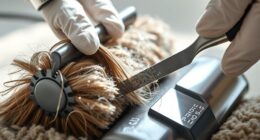Dealing with dirt and mud stains after outdoor fun doesn’t have to be a hassle. First, let the mud dry completely for easier removal. Use tools like a dull knife to scrape it off, and a soft brush for stubborn bits. Treat stained areas with an enzyme-based solution, letting it sit before washing. Always check for lingering stains before drying to avoid setting them. Want more tips on keeping your clothes clean during play? There’s plenty more to explore!
Key Takeaways
- Allow mud to dry completely before scraping off excess for easier removal and to prevent smearing.
- Use a dull knife or spoon to carefully scrape off dried mud and remove loose debris with a brush.
- Apply an enzyme-based pretreatment to heavily stained areas and let it sit for 15-30 minutes before washing.
- Wash mud-stained items separately using the highest temperature allowed by the care label to avoid dirt redepositing.
- Inspect garments after washing; air dry to ensure stains are completely gone before using a dryer.
Letting Mud Dry Before Cleaning

When you encounter a mud stain, it’s best to let it dry before cleaning. Dried mud consists of sand, silt, clay, and organic matter, making it easier to tackle.
Allowing the mud to dry keeps the stain localized, reducing the risk of smearing and pushing dirt deeper into the fabric. Once it’s dried, you can easily scrape it off with a dull knife or spoon edge. This method not only simplifies removal but also cuts down on the chance of creating permanent stains. Plus, you’ll find that you need fewer cleaning products when dealing with dried mud. Letting mud dry allows for more effective cleaning while minimizing damage to your fabrics.
Patience is key; waiting guarantees more effective cleaning and minimizes damage to your fabrics.
Tools and Supplies for Stain Removal
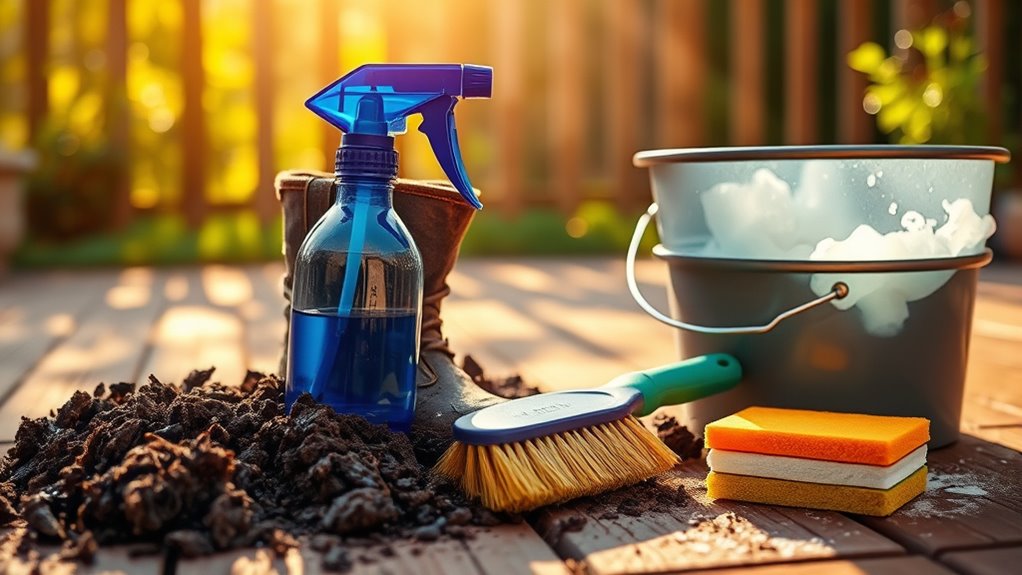
To effectively tackle dirt and mud stains, having the right tools and supplies on hand makes all the difference.
Start with a butter knife or spoon to scrape off dried mud, then use a soft brush or hand vacuum to remove loose debris. An old toothbrush is great for spot cleaning stubborn stains. A clean toothbrush is ideal for brushing off powders like talc or cornflour. Maintaining a clean home is essential for preventing dirt accumulation in the first place, and designating pet-free zones can also help minimize the spread of fur and dirt. Additionally, keeping your home well-lit can enhance visibility when tackling stains, making it easier to notice color accuracy issues that may arise from dirt on surfaces. Regularly using an air purifier with HEPA filters can also aid in reducing airborne dust and allergens that contribute to dirt accumulation.
Begin by scraping off dried mud with a butter knife, then use a soft brush or vacuum to clear away loose dirt. An old toothbrush works wonders for stubborn stains.
For supplies, liquid laundry detergent and a stain remover, preferably enzyme-based, are essential for pre-treating stains. White vinegar and baking soda work wonders too, especially for tough stains. If you prefer eco-friendly options, lemon juice and bicarbonate of soda are effective.
Don’t forget paper towels for blotting and rubber gloves for protection.
With these tools, you’ll be well-equipped to combat those pesky stains!
Effective Pretreatment Methods
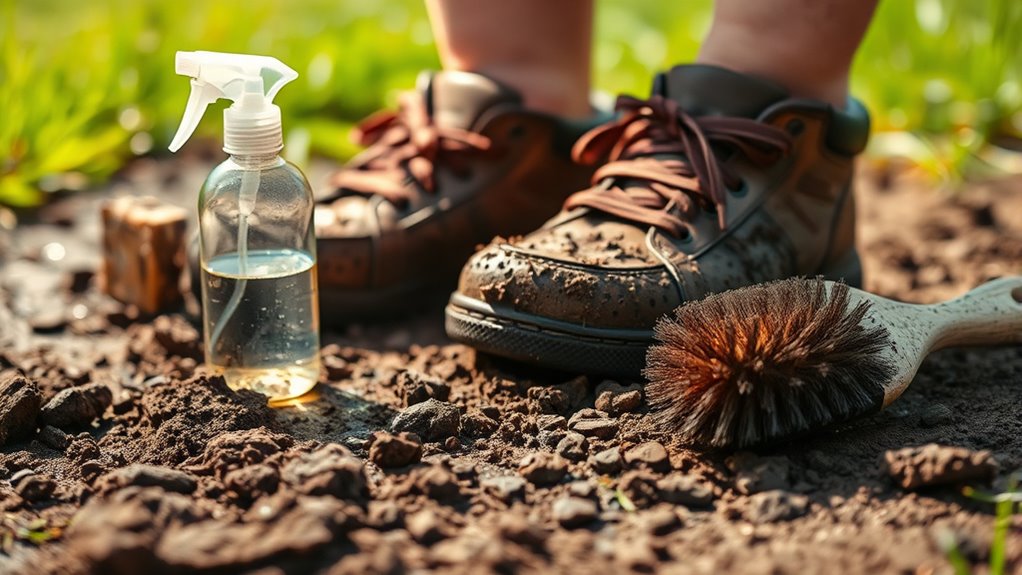
Effective pretreatment methods are essential for removing dirt and mud stains efficiently. Start by allowing any mud to dry completely, then scrape off excess without pressing it deeper. Concentrate your pretreatment on heavily stained areas.
Enzyme-based pretreatments work well, as they break down organic components in stains. Always test new products on a hidden area first to guarantee fabric safety. For stubborn stains, consider using a stain removal gel or spray. Additionally, it’s important to apply high-performance detergent to enhance the cleaning process.
Apply your chosen solution and let it sit for 15-30 minutes for maximum effectiveness. If needed, repeat the application before washing. Remember, using cold water for rinsing helps prevent setting the stain, so stick to that method for the best results.
Washing Techniques for Mud Stains
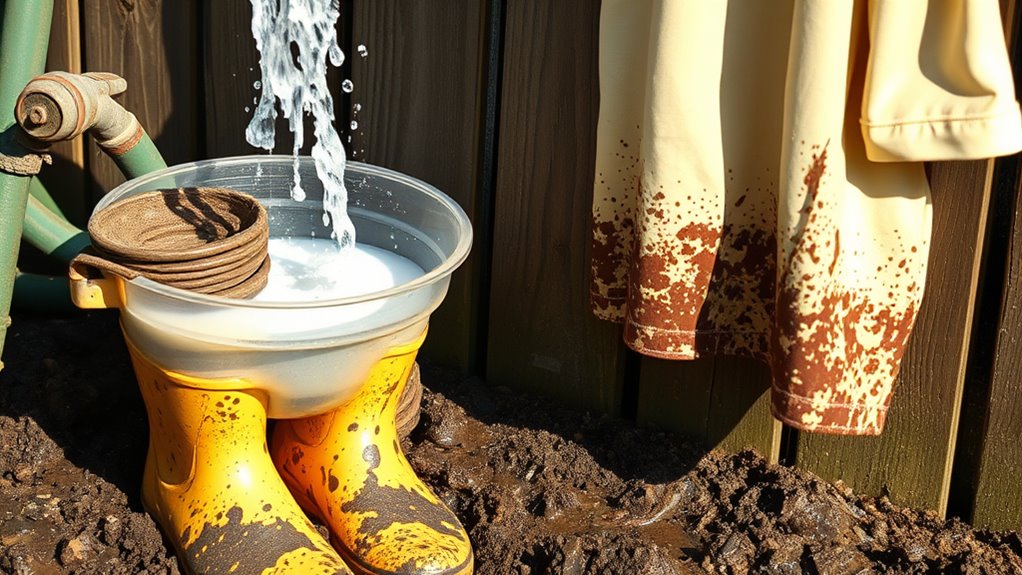
Although washing mud-stained garments might seem straightforward, a few key techniques can considerably enhance your results.
First, let the mud dry before removing excess with a butter knife or vacuum. Check the care label for washing guidelines and choose the highest temperature allowed. Use a high-performance detergent with enzymes to break down the stain effectively. For particularly tough stains, consider using a pre-treatment product beforehand to improve your chances of removal.
Allow mud to dry, then remove excess gently. Follow care instructions and use a strong enzymatic detergent for best results.
If the mud’s stubborn, apply a stain remover beforehand. Consider adding oxygen bleach to boost stain removal. Be cautious—avoid rubbing the stain, as it can push particles deeper.
Also, wash mud-stained items separately to prevent re-depositing dirt onto other clothes. Finally, don’t dry the items until you’re sure the stains are completely gone.
Tips for Drying and Final Checks

Once you’ve washed your mud-stained garment, it’s essential to inspect it carefully before drying.
Look for any remaining stains or odors, as drying can set both permanently. If you spot stains or smell unpleasant odors, repeat the washing process or apply additional stain treatments. Additionally, remember to let it dry completely before further treatment to avoid smearing any remaining mud.
Air drying is your best option at this stage; it allows for a final inspection without the risk of setting the stain. Plus, UV rays from sunlight can aid in naturally whitening and eliminating any lingering marks.
Only once you’re sure the stain is completely gone, consider putting the garment in the dryer. Ensuring it’s free of dirt and stains before storing or wearing it again is vital for maintaining your clothing’s integrity.
Special Considerations for White Clothes
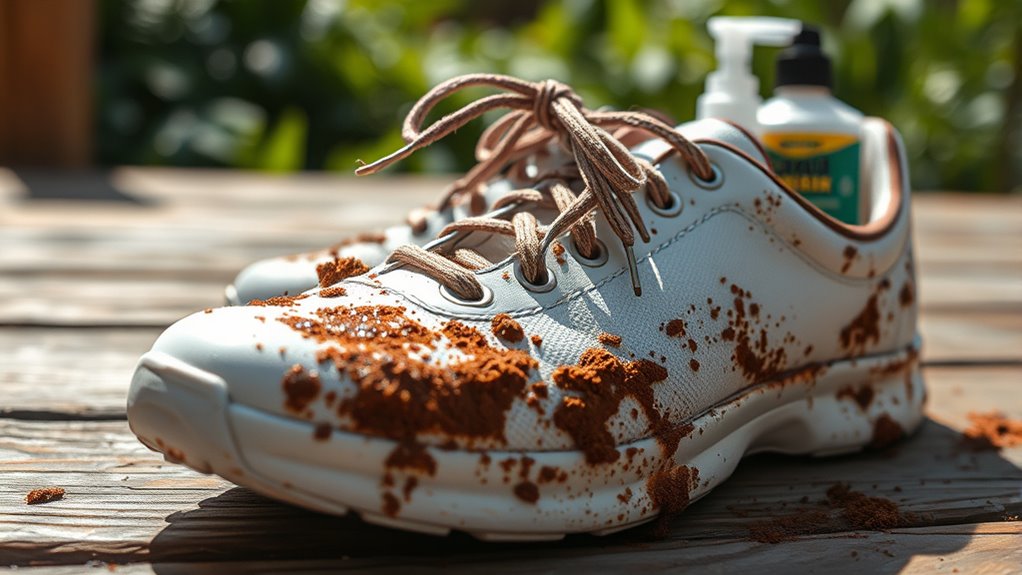
When tackling mud stains on white clothes, it’s crucial to approach the task with care to preserve the fabric’s brightness.
Start by letting the mud dry completely, then gently scrape off the excess with a butter knife.
Pretreat the stain using liquid detergent or stain remover, allowing it to sit for a few minutes. Remember to soak the stain in liquid laundry detergent for at least 15 minutes, rubbing it every 3-5 minutes.
If the fabric allows, mix 1/4 cup of chlorine bleach with a gallon of water for tougher stains.
After washing, air dry your clothes to avoid setting any remaining stains.
For added stain-fighting power, consider soaking your whites in warm water with baking soda or using oxygen bleach.
Always check care labels to verify you’re using safe cleaning methods for your specific fabric.
Managing Stubborn Stains
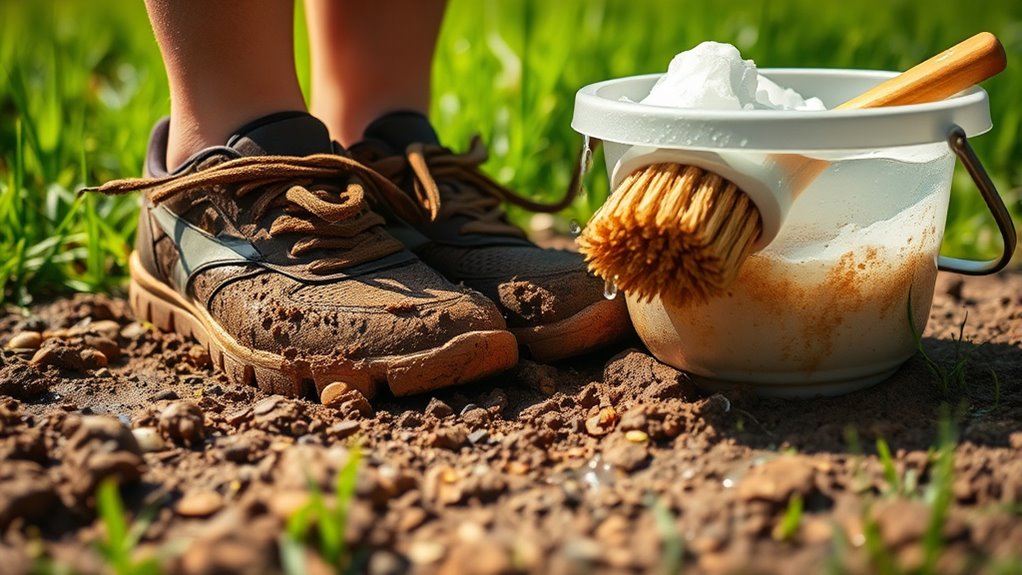
Even with the best care, stubborn stains can still pose a challenge, especially after mud has dried and set.
Start by letting the mud dry completely, then scrape off the excess dirt. Apply a liquid laundry detergent directly to the stain and let it sit for a few minutes. For tougher stains, consider using an enzyme-based detergent or a stain remover like OxiClean. Wash the garment according to its care instructions, preferably using high temperatures if the fabric allows. Immediate action is crucial for effective removal, so don’t hesitate to treat the stain as soon as you notice it. Regular treatment of stains can help maintain carpet longevity and fabric appearance, so be proactive in your cleaning.
If the stain lingers, repeat the process. To tackle odors, soak the item in a vinegar solution or sprinkle baking soda before washing.
Always air-dry your clothes afterward, as heat can set any remaining stains.
Preventive Measures for Future Activities
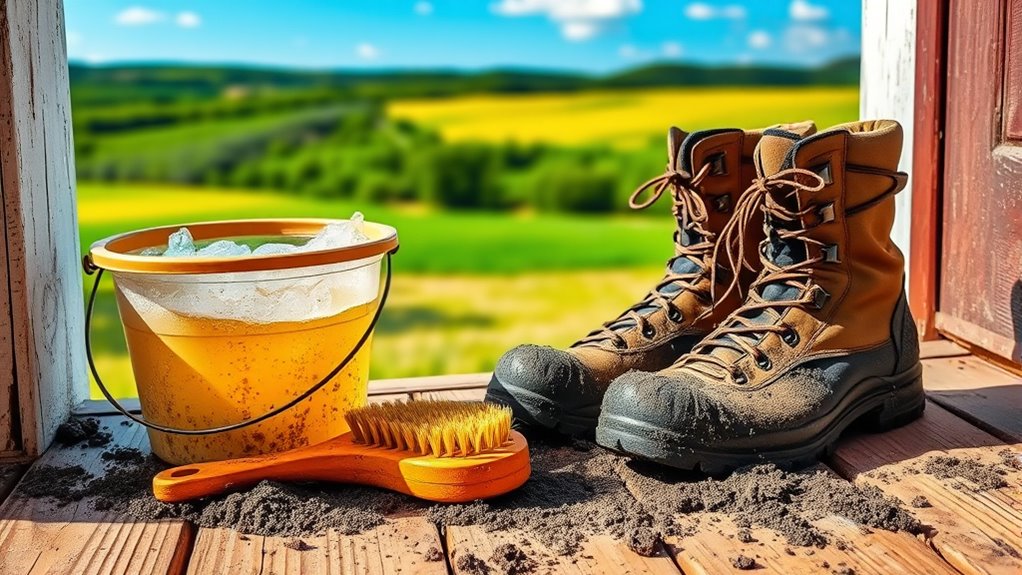
To keep dirt and mud stains at bay during your activities, it’s essential to choose the right clothing and prepare adequately. Opt for durable, water-repellent fabrics that resist mud. Wearing old or inexpensive clothes is a smart choice for messy outings. Layering your clothing adds extra protection, while protective gear like aprons can shield your garments. Remember to gather necessary supplies like stain solutions and brushes before heading out for an effective response to any stains. Incorporating digital literacy resources can also help you find innovative ways to keep your kids engaged while minimizing mess. Equip yourself with boots to protect your footwear, as they can also provide added traction on slippery surfaces. Additionally, selecting toys that encourage physical activity can help keep your kids engaged during outdoor play while reducing the mess. Emphasizing emotional resilience can also encourage children to embrace the joy of outdoor activities, even when messy. Keep a cleaning kit handy and supervise kids to reduce stain risks. Afterward, wash clothes promptly and treat any stains.
Frequently Asked Questions
Can I Wash Mud-Stained Clothes With Other Laundry?
You shouldn’t wash mud-stained clothes with other laundry. Mixing them can spread the stain and soil your other items.
It’s best to treat the mud stains first, letting them dry and gently brushing off excess dirt. After that, wash the stained clothes separately using cold water and an enzyme-based detergent.
This way, you guarantee a thorough cleaning without risking your other garments getting ruined by the mud. Always check for remaining stains before drying.
How Can I Remove Mud Stains From Carpets?
You’d think mud stains are nature’s way of saying your carpet needs more excitement, right?
To tackle those pesky stains, let the mud dry first, then scrape it off gently.
Vacuum up loose dirt, then try a mix of dish soap and warm water to blot the stain.
Rinse with cold water afterwards.
Will Heat Set the Mud Stain if I Dry It?
Yes, heat will set the mud stain if you dry it before completely removing it.
Once the stain dries, it becomes more challenging to eliminate. Avoid using a dryer until you’re sure the stain is gone.
Instead, air dry or sun dry the garment after treating the stain.
Always follow the care label instructions to protect your fabric while tackling those stubborn mud stains effectively.
Can Vinegar Damage My Colored Fabrics?
No, vinegar generally won’t damage your colored fabrics if you use it correctly.
It acts as a natural cleaner and fabric softener without causing discoloration. Just remember to dilute it with water before applying, and always spot test a small area to make certain it doesn’t react adversely with your fabric.
Vinegar’s great for removing stains and odors, so it can be a handy addition to your laundry routine!
Is It Safe to Use Bleach on All Fabric Types?
You can’t put all your eggs in one basket when it comes to using bleach on fabrics.
It’s not safe for all types; while cotton and polyester generally tolerate it, delicate fabrics like silk and wool can be damaged.
Always test a small area first, and remember that chlorine bleach is harsher than oxygen bleach.
Conclusion
So, the next time you find yourself in a muddy escapade, don’t fret! Embrace the adventure and remember these handy tips for tackling those pesky dirt marks. With a little patience and the right approach, you can banish those stains back to the great outdoors where they belong. Just think of it as a badge of honor that tells the tale of your fun-filled day. Happy cleaning, and here’s to more muddy memories ahead!






